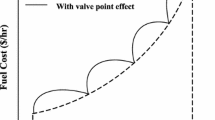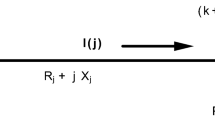Abstract
This article proposes a new strategy for Congestion Management (CM) through Generation Rescheduling (GR) with Distributed Slack Bus (DSB) model using Improved Teaching Learning Based Optimization (ITLBO) algorithm. Most of the previous research mainly focuses on rescheduling the existing generators for CM and least concerned about the consequence of this rescheduling on the slack bus. As a result, the slack bus is supposed to carry the entire residual effect of all other generators which leads to increased Congestion Management Cost (CMC). This work proposes a distributed slack bus model for reducing the excess burden on the slack bus and a two-fold contribution is made to develop the proposed technique. First, is the selection of the participating generator for CM by means of Incremental Generator Sensitivity Factor (IGSF), which adopts the generator sensitivity as well as the bidding cost. Next, CM is formulated as an optimization problem with the objective function involving congestion management cost and solved using ITLBO algorithm, which incorporates the self-motivated learning concept with the basic TLBO operators. For evaluation, the standard IEEE 30-bus and IEEE 118-bus systems are used and the obtained results are compared with the other CM systems reported through literature.








Similar content being viewed by others
Abbreviations
- n :
-
number of buses in the system
- n g :
-
number of generator buses in the system
- n l :
-
number of transmission lines in the system
- P ij :
-
real power flow through line k connected between buses i and j
- Δ:
-
refers to change in a variable
- R u g :
-
incremental bidding cost of generator at bus g in $/MW
- R d g :
-
decremental bidding cost of generator at bus g in $/MW
- ΔP u Gg :
-
incremental real power to be increased on generator at bus g for congestion alleviation
- ΔP d Gg :
-
incremental real power to be decreased on generator at bus g for congestion alleviation
- P 0 Gg :
-
value of real power generation at generator bus g resulted in market clearing procedure
- P min Gg :
-
minimum limit on real power of generator bus g
- P max Gg :
-
maximum limit on real power of generator at bus g
- F k :
-
apparent power flow in MVA through transmission line k connected between buses i and j
- F max k :
-
maximum limit of apparent power flow through transmission line k connected between buses i and j
- F 0 k :
-
apparent power through transmission line k resulted in market clearing procedure
References
Motto A L, 2002 Network-constrained multi period auction for a pool-based electricity market. IEEE Trans. Power. Syst.,17(3): 646–653
Arroyo J M and Conejo A J 2002 Multi period Auction for a pool based Electricity Market. IEEE Trans. Power. Syst.,17(4): 1225–1231
Jiansheng Lei 2001 Congestion management for generator scheduling in a deregulated Chinese power system. In: Proceedings of IEEE PES, Winter Meeting. Columbus, USA
Suganthi S T, Devaraj D and Hosimin Thilagar S 2015 An Improved Differential Evolution algorithm for Congestion Management considering voltage stability. Indian Journal of Science and Technology, 8(24): 0974–6846., September 2015.https://doi.org/10.17485/ijst/2015/v8i24/80243
Talukdar B K, et al 2005 A computationally simple method for cost-efficient generation rescheduling and load shedding for congestion management. Int. J. Elect. Power Energy Syst., 27(5): 379–388
Hazra J, Sinha A K and Phulpin Y 2009 Congestion Management using Generation Rescheduling and/or Load Shedding of Sensitive Bus. In: Proceedings of Third International Conference on Power Systems. Kharagpur, India
Surender Reddy S 2017 Multi-Objective Based Congestion Management Using Generation Rescheduling and Load Shedding. IEEE Transactions on Power Systems, 32(2): 852–863
Leonardo Geo Manescu, et al 2016 Congestion management using dispatch or phase shifting transformers. In: Proceedings of International Conference on Applied and Theoretical Electricity. Craiova, Romania
Singh S N and David A K 2001 Optimal location of FACTS devices for congestion management. Elect.Power.Syst. Res. 58: 71–79
Anwar S. Siddiqu and Tanmoy Deb 2014 Congestion management using FACTS devices. International Journal of System Assurance Engineering and Management, 5(4): 618–627
Tong Shiqiong and Miu K N 2006 Participation factor studies for distributed slack bus models in three phase distribution power flow analysis. In: Transmission and Distribution Conference and Exhibition, IEEE PES. Dallas, TX, USA
Shiqiong Tong and Miu K N 2005 A network-based distributed slack bus model for DGs in unbalanced power flow studies. IEEE Transactions on Power Systems, 20(2): 835–842
Nabavi S M H, Shahram Jadid, Masoum M A S and Kazemi A 2006 Congestion management in nodal pricing with genetic algorithm. In: International Conference on Power Electronics, Drives and Energy Syst. New Delhi, India
Nabavi, S M H, Kazemi, A and Masoum M A S 2011 Social Welfare Improvement by TCSC using Real Code Based Genetic Algorithm in Double-Sided Auction Market. Advances in Electrical and Computer Engineering, 11(2): 99–106
Hazra J and Sinha A K 2008 Congestion management using multi objective particle swarm optimization. In: Proceedings of Power and Energy Society General Meeting - Conversion and Delivery of Electrical Energy in the 21st Century. Pittsburgh, PA, USA
Pandya K S and Joshi S K 2013 Sensitivity and particle swarm optimization based congestion management. Electric Power Components and Systems, 41(4): 465–484
Pal D, Kumar S, Mandal K K and Chakraborty N 2014 Multi-objective congestion management using hybrid differential evolution in a deregulated power system. In: Proceedings of International Conference on Control, Instrumentation, Energy and Communication. Calcutta, India
Preetha Roselyn J, Devaraj D and Subhransu Sekhar Dash 2013 Multi-Objective Differential Evolution for Voltage Security Constrained Optimal Power Flow in Deregulated Power Systems. International Journal of Emerging Electric Power Systems, 14(6): 591–607
Rao R V, Savsani V J and Vakharia D P 2011 Teaching-learning based optimization: a novel method for constrained mechanical design optimization problems. Computer Aided Design, 43(1): 303–315
Rao R V, Savsani V J and Vakharia D P 2012 Teaching-learning based optimization: an optimization method for continuous nonlinear large scale problems. Inf.Sci. 183(1): 1–15
Acknowledgements
This research work was funded by World Bank Group under Robert S McNamara Fellowship Grant.
Author information
Authors and Affiliations
Corresponding author
Rights and permissions
About this article
Cite this article
SUGANTHI, S.T., DEVARAJ, D., THILAGAR, S.H. et al. Optimal generator rescheduling with distributed slack bus model for congestion management using improved teaching learning based optimization algorithm. Sādhanā 43, 181 (2018). https://doi.org/10.1007/s12046-018-0941-8
Received:
Revised:
Accepted:
Published:
DOI: https://doi.org/10.1007/s12046-018-0941-8




